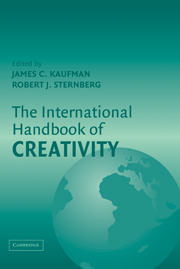Book contents
- Frontmatter
- Contents
- Acknowledgments
- List of Contributors
- 1 Introduction
- 2 Creativity Research in English-Speaking Countries
- 3 Creativity in Latin America
- 4 History of Creativity in Spain
- 5 Past, Present, and Future Perspectives on Creativity in France and French-Speaking Switzerland
- 6 Creativity in Italy
- 7 Creativity Research in German-Speaking Countries
- 8 Creativity Under the Northern Lights
- 9 Creativity in Soviet–Russian Psychology
- 10 Creativity Studies in Poland
- 11 Research on Creativity in Israel
- 12 Creativity in Turkey and Turkish-Speaking Countries
- 13 Development of Creativity Research in Chinese Societies
- 14 Creativity – A Sudden Rising Star in Korea
- 15 Culture and Facets of Creativity
- 16 African Perspectives on Creativity
- 17 Creativity Around the World in 80 Ways … but with One Destination
- Author Index
- Subject Index
- References
11 - Research on Creativity in Israel
A Chronicle of Theoretical and Empirical Development
Published online by Cambridge University Press: 05 June 2012
- Frontmatter
- Contents
- Acknowledgments
- List of Contributors
- 1 Introduction
- 2 Creativity Research in English-Speaking Countries
- 3 Creativity in Latin America
- 4 History of Creativity in Spain
- 5 Past, Present, and Future Perspectives on Creativity in France and French-Speaking Switzerland
- 6 Creativity in Italy
- 7 Creativity Research in German-Speaking Countries
- 8 Creativity Under the Northern Lights
- 9 Creativity in Soviet–Russian Psychology
- 10 Creativity Studies in Poland
- 11 Research on Creativity in Israel
- 12 Creativity in Turkey and Turkish-Speaking Countries
- 13 Development of Creativity Research in Chinese Societies
- 14 Creativity – A Sudden Rising Star in Korea
- 15 Culture and Facets of Creativity
- 16 African Perspectives on Creativity
- 17 Creativity Around the World in 80 Ways … but with One Destination
- Author Index
- Subject Index
- References
Summary
Israel is a small country in which the academic and creative abilities of people are considered a major natural resource (Milgram, 2000). The identification and education of gifted and talented children and adolescents have been the focus of considerable interest in Israel for many years. The rationale underlying this interest is that a small country, bereft of natural resources, must place high priority on its human resources, that is, on the abilities and talents of its people. This chapter is divided into four sections. In the first section, we present a summary of research in Israel on topics of creativity. In the second section, we present a theoretical model of the structure of giftedness and creativity (Milgram, 1989, 1991) that has generated the bulk of theory-driven empirical research on creativity in Israel. In the third section we report on international research on learning style and creativity that included Israel, and in the fourth section we discuss new directions in research on creativity in Israel.
CREATIVITY RESEARCH IN ISRAEL
In an effort to include in this chapter as much of the research done in Israel on creativity as possible, we conducted a computerized search by using several electronic databases, including FirstSearch (ERIC and MEDLINE) and EBSCO (PsychINFO). We searched these databases for the years from 1970 to 2004, using creativity and Israel as the two leading keywords and combinations of creativity and Israel with other keywords. This search yielded fourteen studies that we considered appropriate to report in the current section.
- Type
- Chapter
- Information
- The International Handbook of Creativity , pp. 307 - 336Publisher: Cambridge University PressPrint publication year: 2006
References
- 7
- Cited by



